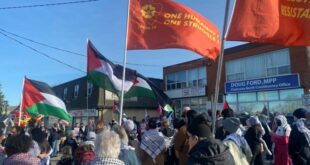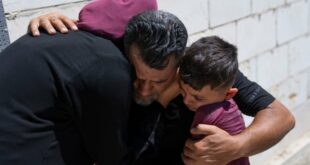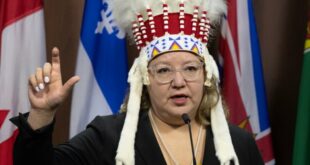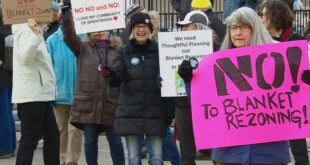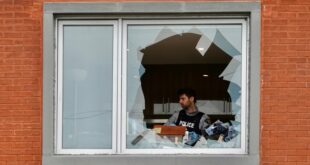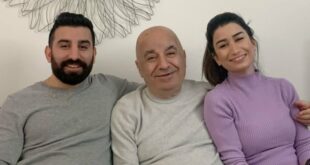Video shows forceful arrest after foot chase in Orléans in February.

Kane Niyondagara was walking home from a Starbucks in Ottawa’s east end when he heard the sirens.
He turned around and, according to his description of what happened to him on the morning of Feb. 16, saw police officers with weapons pointed at him on Innes Road.
“Hands up,” they ordered. He obeyed.
“Get on your knees,” he remembers one officer calling.
But Niyondagara, 27, hadn’t done anything wrong. He dropped his hands and shrugged, as if to ask why. He looked at the sidewalk under his feet and said he was afraid of being “brutally arrested” against the hard concrete.
“They just kept screaming to get on the ground,” he said. “As I was really scared, I didn’t get on the ground. I just waited.”
He waited, he said, until a police officer came too close. Then he ran.

The Ottawa Police Service (OPS) won’t say much about that encounter or what followed, except to explain that it was all a case of mistaken identity.
Niyondagara, who is Black, said he was shocked with a stun gun, pinned down, struck in the face and handcuffed before police realized their mistake. Parts of the incident were captured on video by a bystander who shared it with CBC News.

[WARNING: Video contains graphic footage] Kane Niyondagara pinned by police
Kana Niyondagara, who is Black, said he was shocked with a stun gun, pinned down, struck in the face and handcuffed before police realized their mistake. Parts of the action were captured on video by a bystander.
Niyondagara said police would later ask if he knew anyone called “Gibriil” — a stranger whose name matches a wanted murder suspect who is also Black.
CBC has confirmed Niyondagara does not have a criminal record.
The case comes just weeks after Toronto police admitted misconduct for shocking a Black university student with a stun gun and kneeing him in the neck in another case of mistaken identity.
In Ottawa, 2022 statistics from the city’s police board show Black people made up one-quarter of those against whom police use force, and 17 per cent of those against whom officers discharge stun guns, even though just eight per cent of the city’s population is Black.
Niyondagara believes race played a factor in the way he was treated that morning. He’s now sharing his story because he wants justice and accountability.
‘I felt the shock’
Niyondagara said as he ran east along Innes Road, a police car raced forward and almost hit him. He said he stopped at a red light, pressed the button and waited for it to turn green.
“As I was waiting, I saw the police cars and everybody that was behind me catch up with me, get out of the cars, try to talk to me, just to tell me they were going to Tase me if I kept running,” he said.
“I was like, ‘Why? Why would you Tase me? What did I do?'” he added. “Nobody told me.”
According to Niyondagara, he turned around and then felt a sharp pain in his back.
“I felt the shock,” he said. “I smelled something, but it did not stop me from running away. I just pulled out the needle of the Taser out of my back and kept running.”

He kept running toward his home on Prestwick Drive, but didn’t get much farther. Zak Boudreau saw what happened next from his home across the street, near Summerlands Crescent.
“I heard sirens, so I looked out the window and then I saw a cop car stop, a gentleman walking with his hands up, and then the cops tackled him to the ground,” Boudreau said.
He turned on the video recorder on his phone.
The video shows three police officers on top of a man. One can be seen forcing his knee into the man’s back. He does it at least twice more, though not as hard as the first time. A fourth officer then enters the frame and forces the man’s face down into the snow.
Niyondagara said it was hard to breathe with so many knees pressed into his back. The snow made it much worse, as his face was pushed into the frozen ground.
“I was just trying to blow the snow away … so I could breathe properly,” he said.
‘They kept hitting him’
Niyondagara said he was again shocked with a stun gun while on the ground, though Boudreau’s brief video does not capture that. OPS will neither confirm nor deny to CBC that officers used conducted energy weapons during the chase and altercation.
But an ambulance call report from the Ottawa Paramedic Service confirms that they did, citing “officers on the scene.”
“Police chased the patient and ended up Tasing him in the back but the probes did not go in properly,” according to the report. It does not reveal where the weapon was used or how many times.
The same report also confirms much of Boudreau’s description and the events in his video, except to say that Niyondagara “fell on his back” instead of being tackled. It says he was “punched in the head by an officer and was held down by more officers” and “received knee kicks on the right side of his body.”
Niyondagara said he fell on the ground to protect himself and then an officer jumped on him.

Paramedics conducted a physical examination and recorded that Niyondagara had a “minor puncture wound” consistent with an “electronic probe device.”
Boudreau and Niyondagara have different estimates of how long he was pinned on that spot, but both agreed it lasted for several minutes.
Niyondagara said he wasn’t resisting or even moving much while on the ground.
“I was just waiting for the handcuffs,” he said.
Boudreau said he saw no signs of resistance from Niyondagara.
“He didn’t really seem to be struggling at all, but they kept on hitting him, screaming at him,” Boudreau said. “It looked really aggressive.”
He specified that the hitting did not last through the entire episode.
“It’s not like they were beating him up the whole time,” Boudreau said.
‘There was a misunderstanding’
Ottawa police would not answer detailed questions about the chase or the actions of the officers who responded, except to provide the following statement:
“The Ottawa Police Service (OPS) received a call for service about a wanted person who was seen in the area,” it said. “When police arrived, the person ran away from police and a chase ensued.
“While we will not provide further comments on the incident, so as to protect the privacy of the individual, we can confirm that it was a case of mistaken identity,” the statement added. “The person was spoken to and released unconditionally.”
OPS added that the call for service was reviewed by the chain of command and said the force will reach out to the person involved “to discuss the police response and any concerns.”
Niyondagara said he was handcuffed, searched and put into a police cruiser. He said police, who at this point had his identification, asked him if he knew a person by the name of “Gibriil.”

OPS have been seeking Gibriil Bakal for first-degree murder in connection with a fatal shooting on Jan. 29 near Little Italy. Police confirmed last week that Bakal, who was 29 as of Feb. 12, remains at large and is still wanted.
After some discussion about the name Gibriil, the police officer left the cruiser and soon returned to explain “that there was a misunderstanding,” Niyondagara said.
“The guy who they were looking for looked exactly like me and he was a criminal,” he recalls police explaining to him.
According to Leanna Rizzi, a communications manager with Starbucks Coffee Canada, police had visited their Innes Road location on Feb. 13, three days before Niyondagara was arrested, as part of an investigation.
“As always, we do our very best to cooperate with the local authorities,” she wrote in an email to CBC.
But Rizzi did not respond to questions about what led police to respond to the scene on the morning of Feb. 16, just after Niyondagara left the coffee shop, or specifically whether Starbucks staff had called police.
Police will not confirm whether Bakal was the subject of the call for service reporting a “suspicious person” that morning.

Whatever the full explanation, Niyondagara was relieved to hear it was all a mistake. He had feared he was under suspicion of jaywalking — wrongly, he said — after leaving Starbucks.
“I still had six seconds,” he insisted.
Kept handcuffed while being treated
After paramedics arrived at the scene, police asked Niyondagara if he needed medical attention.
“I said, ‘No, I’m good, I’m fine,'” he recalled. “I just want[ed] to get home, because I really needed to get cleaned up.”
Eventually he relented and was brought to the ambulance, still handcuffed.
“They did all the checkups, which was really almost impossible because they couldn’t remove my jacket, my hoodie, with the handcuffs,” Niyondagara said.
He estimates he was handcuffed for at least 20 minutes in total. During most of that time, he said, police had his identification and had admitted their error.
He said officers removed the handcuffs only when he was asked to sign a document confirming he had received medical attention.
Police did not answer a question posed by email about how long Niyondagara was handcuffed after they learned his identity, nor does the ambulance call report address the issue. Boudreau said Niyondagara was still handcuffed when he left the police cruiser and entered the ambulance.
After Niyondagara declined a trip to the hospital, police took him home. One officer apologized, though Niyondagara said he was not among those who had held him down.
Niyondagara’s brother Shane remembers seeing him with an injured face once he entered the house.

“I was feeling my lungs had actually a hole in them,” said Niyondagara. “I was coughing really bad … I was feeling some pain over here, all over the side of the face, because the punch was really hard and it took many days to heal.”
He said it was painful to open his jaw to eat for days.
The incident also took an emotional toll. Niyondagara said he felt “disrespected.” He said he was embarrassed, and initially didn’t want to talk about what happened.
But then his mother saw the bruise on his face.
“It’s a long story,” he told her. “I have to tell you when you’re sitting.”
Why did he run?
Niyondagara has filed a formal complaint with the Office of the Independent Police Review Director, a provincial civilian agency that oversees police services. He said he wants to “bring a little bit of justice” after his ordeal and ensure it doesn’t happen again.
Why did Niyondagara run? His parents both suggested that it could stem from his upbringing in Burundi, a country in East Africa ruled by an oppressive regime.
“In our country, when you see a policeman or military, the first reaction would be to run,” said his mother Ernestine Mosozi. “You just better run or hide so you don’t get shot.”
At first, Niyondagara only mentioned that hard sidewalk on Innes Road.
“It was cement all around me, so I was feeling anxious and scared to do that because my life would be in danger if I was treated like a criminal,” he said. “I know it can be a brutal arrest.”
But asked about his parents’ theory, he agreed that his memories of growing up in Burundi played a role. He remembers how police there responded to protests.
“They were just coming to brutalize people, to kidnap people, to spray people, to do bad things, because they were corrupt,” he said.
Those memories have stuck with him.
“It’s part of me. It’s part of who I am.”
Niyondagara also believes his race “played a big role” in the way police treated him that day, and said he wants an apology from the police officer who struck him.
“He should face the situation, the emotion,” Niyondagara said.
ABOUT THE AUTHOR
Arthur White-Crummey is a reporter at CBC Ottawa. He has previously worked as a reporter in Saskatchewan covering the courts, city hall and the provincial legislature. You can reach him at arthur.white-crummey@cbc.ca.
*****
Credit belongs to : www.cbc.ca
 Atin Ito First Filipino Community Newspaper in Ontario
Atin Ito First Filipino Community Newspaper in Ontario
